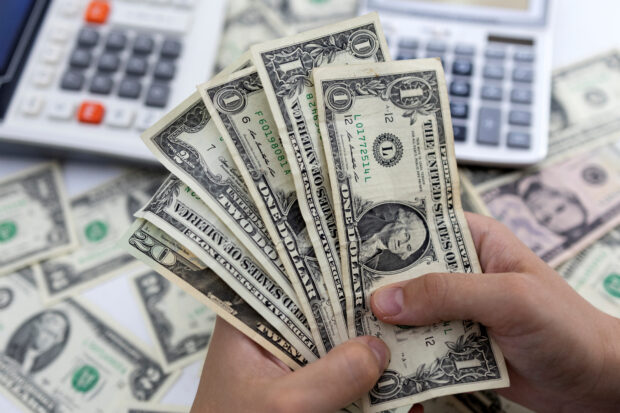Dollar eases as Fed minutes offer few clues on rate cuts timeline

Woman holds U.S. dollar banknotes in this illustration taken May 30, 2022. REUTERS/Dado Ruvic/Illustration/File Photo
LONDON/SINGAPORE -The dollar fell on Thursday, after rising to an almost three week high a day earlier, with minutes of the Federal Reserve’s last meeting providing few clues on when the United States might start cutting interest rates.
Minutes of the December policy meeting released on Wednesday showed Fed officials convinced inflation was coming under control and concerned about the risks of the central bank’s “overly restrictive” monetary policy on the economy.
However, there were no clear-cut clues on when the Fed could begin easing rates, with policymakers still seeing a need for rates to stay restrictive for some time.
Against a basket of currencies, the greenback fell 0.11 percent to 102.29, after hitting a three-week peak of 102.73 on Wednesday.
“The messaging that rates will stay elevated raises a second look at the aggressive cut expectations markets are pricing,” said Christopher Wong, a currency strategist at OCBC.
Separate data on Wednesday showed U.S. manufacturing contracted further in December, though the pace of decline slowed, while U.S. job openings fell for the third straight month in November, pointing to easing labor market conditions.
READ: US manufacturing mired in weakness, economy heading for slowdown
Recent data pointing to a cooling U.S. economy has continued to underpin bets of Fed rate cuts this year as inflation comes under control, though traders remain divided over the pace and scale of easing from the central bank.
Market pricing now shows a roughly 72 percent chance that the Fed could begin cutting rates in March, compared with an 87-percent chance a week ago, according to the CME FedWatch tool.
The closely watched U.S. nonfarm payrolls report is due on Friday, which will likely give further clarity on how much room the Fed has to lower rates.
Focus on Euro Zone inflation
The euro rose 0.25 percent to $1.0950, having fallen to a more than two-week low on Wednesday, after France and other European countries reported inflation figures.
Markets expect a rebound in headline inflation in the euro zone in the December print due on Friday.
France’s INSEE official statistics agency reported an EU-harmonized inflation rate of 4.1 percent in December, as expected by economists polled by Reuters.
READ: ECB expects euro zone 2024 inflation to remain above 3% – source
The German state of North Rhine-Westphalia, the most populous, reported an inflation rate of 3.5 percent in December, rising from 3 percent in November. Germany’s nationwide inflation figure is due at 1300 GMT.
“There are some risks that a higher headline print will prompt some repricing of the highly dovish European Central Bank rate expectations,” said Francesco Pesole, FX strategist at ING.
“We could see some euro performance emerging in the crosses in the short run but some improvement in the euro zone economic outlook remains necessary to make any rally sustainable”.
Sterling rose 0.25 percent to $1.2694.
Risk sentiment
Elsewhere, the Australian dollar, often used as a proxy for risk appetite, rose 0.2 percent to $0.6744, breaking away from Wednesday’s two-week low of $0.6703.
The risk-sensitive New Zealand dollar also rose 0.26 percent to $0.6263, having similarly touched a two-week low of $0.6221 in the previous session.
The greenback pushed to an over two-week high against the yen, with Japan back from an extended New Year break.
The dollar peaked at 143.90 yen and last changed hands at 143.71, up 0.3 percent .
In geopolitics, Hezbollah in Lebanon and the Israeli army made statements suggesting the two avowed enemies wanted to avoid the further spread of war beyond the Gaza Strip, after a drone strike killed a Palestinian Hamas deputy leader in Beirut.